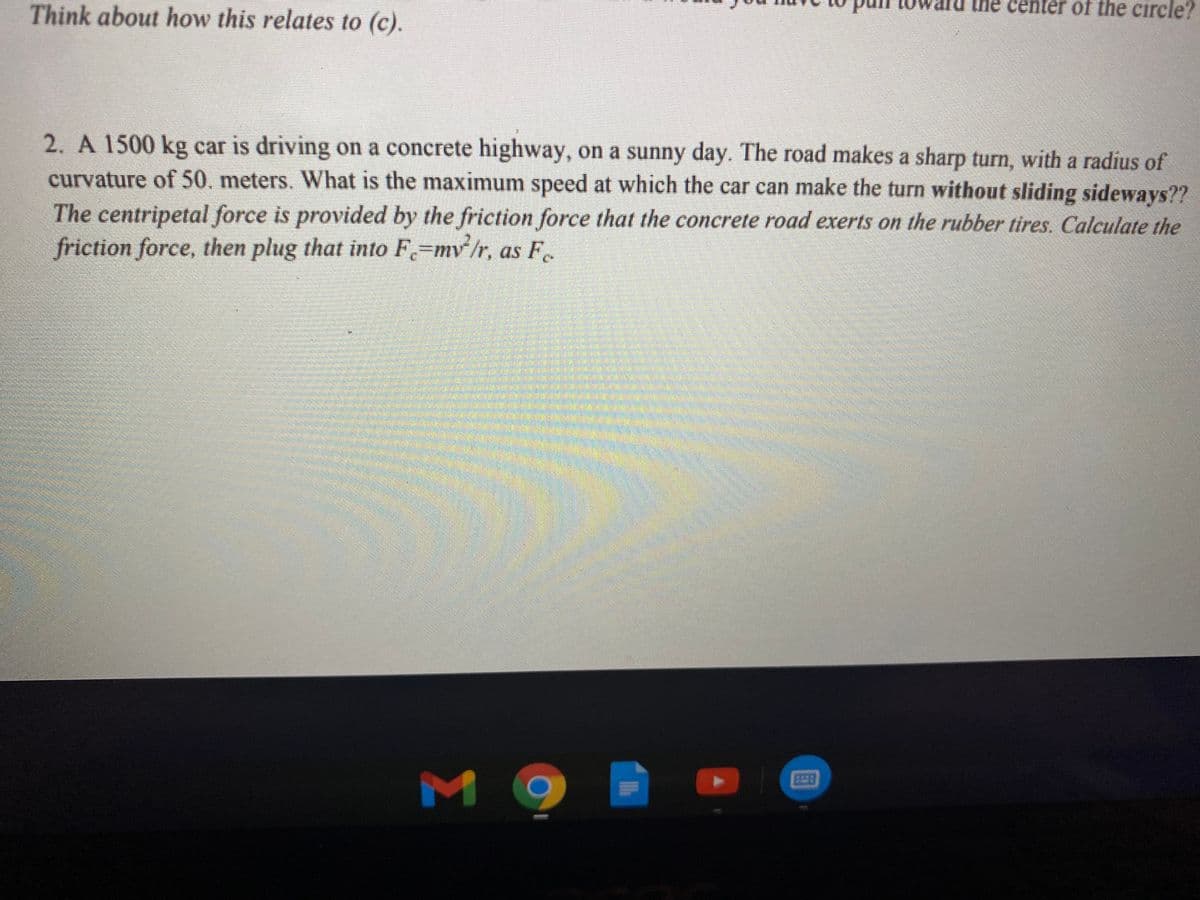2. A 1500 kg car is driving on a concrete highway, on a sunny day. The road makes a sharp turn, with a radius of curvature of 50. meters. What is the maximum speed at which the car can make the turn without sliding sideways?? The centripetal force is provided by the friction force that the concrete road exerts on the rubber tires. Calculate the friction force, then plug that into F=mv/r, as F.
2. A 1500 kg car is driving on a concrete highway, on a sunny day. The road makes a sharp turn, with a radius of curvature of 50. meters. What is the maximum speed at which the car can make the turn without sliding sideways?? The centripetal force is provided by the friction force that the concrete road exerts on the rubber tires. Calculate the friction force, then plug that into F=mv/r, as F.
Chapter2: Loads On Structures
Section: Chapter Questions
Problem 1P
Related questions
Question

Transcribed Image Text:Think about how this relates to (c).
Ihe center of the circle?
2. A 1500 kg car is driving on a concrete highway, on a sunny day. The road makes a sharp turn, with a radius of
curvature of 50. meters. What is the maximum speed at which the car can make the turn without sliding sideways??
The centripetal force is provided by the friction force that the concrete road exerts on the rubber tires. Calculate the
friction force, then plug that into F.-mv/r, as F
M 9
EESE
Expert Solution
Step 1 If there is no provision of super elevation on road
If there is no super elevation then centripetal force will be the function of friction only
Friction which is generally consider to be generated on b/w tyre and road in lateral direction is 0.15
Trending now
This is a popular solution!
Step by step
Solved in 2 steps

Knowledge Booster
Learn more about
Need a deep-dive on the concept behind this application? Look no further. Learn more about this topic, civil-engineering and related others by exploring similar questions and additional content below.Recommended textbooks for you


Structural Analysis (10th Edition)
Civil Engineering
ISBN:
9780134610672
Author:
Russell C. Hibbeler
Publisher:
PEARSON

Principles of Foundation Engineering (MindTap Cou…
Civil Engineering
ISBN:
9781337705028
Author:
Braja M. Das, Nagaratnam Sivakugan
Publisher:
Cengage Learning


Structural Analysis (10th Edition)
Civil Engineering
ISBN:
9780134610672
Author:
Russell C. Hibbeler
Publisher:
PEARSON

Principles of Foundation Engineering (MindTap Cou…
Civil Engineering
ISBN:
9781337705028
Author:
Braja M. Das, Nagaratnam Sivakugan
Publisher:
Cengage Learning

Fundamentals of Structural Analysis
Civil Engineering
ISBN:
9780073398006
Author:
Kenneth M. Leet Emeritus, Chia-Ming Uang, Joel Lanning
Publisher:
McGraw-Hill Education


Traffic and Highway Engineering
Civil Engineering
ISBN:
9781305156241
Author:
Garber, Nicholas J.
Publisher:
Cengage Learning